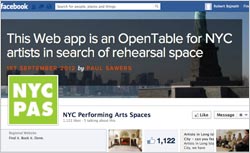Arts Groups Embrace Digital Tools
- by Mark Walsh @markfwal, January 4, 2013

The digital revolution has caught up with the arts. A new survey of U.S.-based arts groups shows that the Internet, social media and mobile connectivity are key parts of their operations and have changed how they stage shows, mount exhibits, sell tickets and interact with audiences.
The study by the Pew Research Center’s Internet & American Life project involved 1,244 arts organizations that receive funding from the National Endowment for the Arts. It found that digital technologies are changing the very definition of art, with 77% agreeing the Internet has “played a major role in broadening the boundaries of what is considered art.”
Highlighting the broad impact of the Web and other technologies on the arts, it was noted that 83% of the organizations say these technologies have made their audiences more diverse; 78% say digital technologies are “very important” for increasing audience engagement; and 64% say they are “very important” for fundraising.
Nearly all arts groups have their own Web site, as well as a presence on sites like Facebook, YouTube and Flickr. In addition, most accept donations online, sell tickets and maintain blogs. Almost a quarter (24%) use mobile apps to offer content, while 15% use apps to sell tickets or services.
Social media in particular has played a central role in making art a more participatory experience. Findings: 90% allow patrons to share their content via email, Facebook, or Twitter; 82% use social media to engage with audience members before, during, and after events; 52% use social media to crowdsource ideas from programming decisions to optimal times for sessions or seminars; and 35% use location services such as Yelp, Google Latitude or Foursquare to interact with patrons.
The report, however, also suggested the widespread adoption of technology tools in the arts world has had less desirable effects. These range from the challenge of dealing with unfiltered public criticism to decreasing attendance for live performances to undercutting some arts groups’ missions and revenue streams.
The modern scourge of cell phones disrupting live performances was also cited as a major source of irritation among arts groups, with 71% decrying ringing phones or people texting during shows or concerts.
The survey underlying the study was conducted from May 30 to July 20, 2012, providing a sample of respondents across the visual arts, music, theater, dance, literature, photography and media arts. It also covers a range of functions including performance, curation, education and philanthropy.


